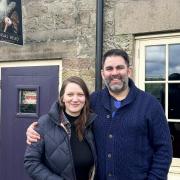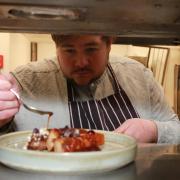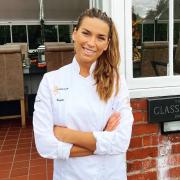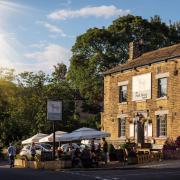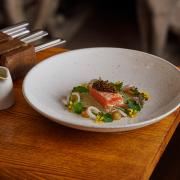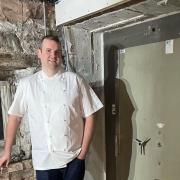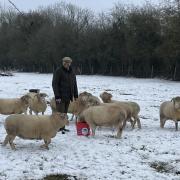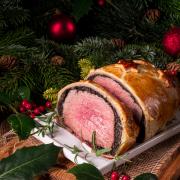Derbyshire’s highest hostelry has been welcoming guests for over 250 years, but just remember to take your coat, advises Andrew McCloy
For spectacular pub locations the Barrel Inn at Bretton is hard to beat, perched high and remote on the roof of the Peak District.
It’s Derbyshire’s highest pub, situated north of Bakewell on a long gritstone ridge that provides the backdrop to the villages of Eyam, Foolow and Great Hucklow.
At 1,250ft high, the views southwards into the heart of the national park are stunning, but over the years this exposed location has come at a cost.
The Barrel is one of a cluster of buildings that make up the hamlet of Bretton and there has been a dwelling at this site for over 400 years.
It was originally a farmhouse which, if a painting in the present-day bar is anything to go by, was originally thatched.

There is also speculation that the original Barrel Inn was once at nearby Nether Bretton Farm, but what’s certain is that weary and sometimes weather-beaten travellers have been coming through the door for refreshment and shelter since 1753, the first landlord recorded as George Bowman, who served until 1770.
The pub has also had other regulars over the years, as for several centuries this was a busy lead mining area and cottages at Bretton were once home to miners and their families.
Most work had ceased by the turn of the 20th century, although Ladywash Mine to the east of Bretton only closed in 1979.
Below the ridge is Hucklow Edge lead vein, one of several mineral-rich veins which have left the ground riddled with shafts, tunnels and fissures.
It’s also created small caves and caverns deep underground, including one said to be shaped like a barrel - and it’s this that supposedly gave the pub its name.
Not unnaturally, miners would regularly slake their thirst in local inns and pubs, but it was also because of a commonly held belief that ale protected them from lead poisoning.
There’s also an entertaining story about how the Barrel Inn was where local miners ran a burial club, which was a sort of benefit society common in the 19th century whereby people would pay in to a local fund to help each other cover the cost of a funeral.
However, the Bretton club had an unusual rule requiring members to givTheThe Barrel Inn is Derbyshire's highest pub and has a long and fascinating history Barrel Inn is Derbyshire's highest pub and has a long and fascinating historye two weeks’ notice of a death or the money would not be paid.

Perhaps unsurprisingly there were never any claims and so the miners spent the fund on a party at the Barrel Inn every Christmas!
The other notable building at Bretton is the youth hostel, built by the YHA in the 1960s on the site of a former farmstead and now run as an independent hostel.
In its grounds are four stones marking the site of the Bretton Plague Graves, aThe Barrel Inn glimpsed through snowdrifts on the first day of Spring, 1979 (photo Jack Bricklebank, courtesy of Derwent Gallery, Grindleford) reminder that although the Black Death took an infamous toll on nearby Eyam there were others in neighbouring communities that also perished.
Two of the graves are of Ann and Peter Morton, who lived at the Barrel Inn, and before the plague died out at the end of 1666 the family lost several more members.
The road that runs past the Barrel now brings car drivers and cyclists, but in late medieval times this was the route of packhorses plying the trading route from Cheshire into South Yorkshire; and was probably responsible for sustaining a pub at this remote location.
It was made into a turnpike in the mid-1700s and for horse-drawn carts and coaches heading west from Sheffield to Buxton, in particular, the route became notorious for the climb up from the Derwent crossing at Grindleford along the Sir William Hill Road – an ascent of 500 feet in little over half a mile.
In 1795 the turnpike was switched to a lower and less demanding route via Eyam and Foolow.
However, on the top of Eyam Edge the ground is broad and mostly level and it was here, long ago, that it was not uncommon to see racehorses being put through their paces.
According to research by Frank Rodgers, the so-called ‘Bretton Race Course’ was where horses were trained for the Sheffield Handicap, not least because the air was fresher and cleaner than that around the city. It’s also likely a few wagers were taken and the winnings spent in the Barrel Inn!

SNOWED IN
At 1,250ft (380m) above sea level, the Barrel Inn proudly proclaims it’s the highest pub in Derbyshire, although in the wider Peak District it has to look up to the Cat and Fiddle (at 1,690ft) which sits in Cheshire and the New Inn (1,518ft) located at Flash in Staffordshire.
However, in terms of views from the pub itself the Barrel is arguably unsurpassed and on calm, sunny days customers can sit outside and enjoy a glorious panorama southwards across the open and unspoilt plateau, its intricate field patterns and spiders’ web of drystone walls stretching far into the distance.
This is the last of the lower and gentler limestone country before the higher and rougher gritstone of the northern Peak District takes over – in other words, where the White Peak becomes the Dark Peak.
The higher and more challenging terrain often has weather conditions to match, as evidenced by the pub’s heavy duty front door and porch; and the fact a fire is lit in the bar for a significant part of the year.
The Barrel has seen its share of notable weather events, but nothing compares to January 1947.
Like most of the country, Derbyshire suffered up to six weeks of snowstorms, as well as plunging temperatures that got as low as -18 degrees Celsius in Buxton.
Out in the Peak District countryside conditions were atrocious and small communities like Bretton became marooned, with snow drifting as high as 20 feet and roads entirely impassable.
Although accounts vary, the Barrel Inn was completely cut off from all contact with the outside world for between two to three weeks.
An eyewitness account from a man who eventually struggled up to Bretton from Eyam describes how drifting snow was piled up around the pub, obliterating every window so that the building resembled a ‘huge igloo’.
When more help arrived a tunnel had to be dug from the outside to locate the front door. Thankfully, publican Stanley Drewett and his wife emerged unscathed, no doubt sustained on the pub’s stock of supplies.
Blizzards continued until March and the Barrel was effectively out of reach for over five weeks. There are archive photos on the walls of the bar that show the extreme conditions the pub has had to endure, including one (reproduced here) of snowdrifts outside the pub in March 1979.
Despite the sometimes inhospitable conditions outside, the interior of this traditional and robust stone building is comfortable and cosy.
With its thick-set walls, heavy studded doors and low slung oak beams, the long main bar has attractive window seats and snug seating around the open fire.
There are rooms with stone-flagged floors, ideal for groups of ramblers and cyclists, while if you fancy staying overnight the pub has five en-suite rooms.
The present owners of the Barrel are Di and Phil Cone, who have been at the pub for 26 years. Over that time, they have created a new kitchen, added the weather-proof porch and refurbished the guest rooms.
With few immediate ‘locals’, the Barrel is a destination pub in every sense and they pride themselves on good quality food and drink served daily.
Once you’ve had your fill, wander out front and take in the view – just remember to wear an extra layer.
Peak District Pubs: A pint-sized history by Andrew McCloy is published by Gritstone at £11.99 www.gritstonecoop.co.uk/product/peak-district-pubs.








